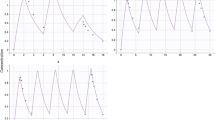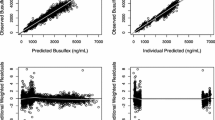Abstract
Purpose
This study aimed to develop a population pharmacokinetic (PPK) model to investigate the impact of GSTA1, GSTP1, and GSTM1 genotypes on busulfan pharmacokinetic (PK) variability in Chinese adult patients.
Methods
Forty-three and 19 adult patients who underwent hematopoietic stem cell transplantation (HSCT) were enrolled for modeling group and validation group, respectively. All patients received twice-daily intravenous busulfan as part of conditioning regimen before HSCT. The PPK model was developed by nonlinear mixed-effect modeling. Covariates investigated were age, sex, actual body weight, body surface area, diagnoses, hepatic function markers, GST genotypes and conditioning regimen.
Results
A total of 488 busulfan concentrations from 43 patients were obtained for the PPK model. The PK of intravenous busulfan was described by one-compartment model with first-order elimination with estimated clearance (CL) of 14.2 L/h and volume of distribution of 64.1 L. Inclusion of GSTA1 genotype as a covariate accounted for 1.1% of the inter-individual variability of busulfan CL (from 17.8% in the basic model to 16.7% in the final model). The accuracy and applicability of the final model were externally validated in the independent group. The difference of busulfan PK between Chinese patients and Caucasian patients existed because of the rarity of haplotype *B in Chinese population.
Conclusions
Although the GSTA1 genotype-based PPK model of intravenous busulfan was successfully developed and externally validated, the GSTA1 genotype was not considered to be clinically relevant to busulfan CL. We did not suggest the guidance of GSTA1 genotype on initial busulfan dose in Chinese adult patients.



Similar content being viewed by others
References
Ciurea SO, Andersson BS (2009) Busulfan in hematopoietic stem cell transplantation. Biol Blood Marrow Transplant 15(5):523–536
Copelan EA, Bechtel TP, Avalos BR et al (2001) Busulfan levels are influenced by prior treatment and are associated with hepatic veno-occlusive disease and early mortality but not with delayed complications following marrow transplantation. Bone Marrow Transplant 27:1121–1124
Bolinger AM, Zangwill AB, Slattery JT et al (2000) An evaluation of engraftment, toxicity and busulfan concentration in children receiving bone marrow transplantation for leukemia or genetic disease. Bone Marrow Transplant 25:925–930
Lee JW, Kang HJ, Lee SH et al (2012) Highly variable pharmacokinetics of once-daily intravenous busulfan when combined with fludarabine in pediatric patients: phase I clinical study for determination of optimal once-daily busulfan dose using pharmacokinetic modeling. Biol Blood Marrow Transplant. 18(6):944–950
Paci A, Vassal G, Moshous D et al (2012) Pharmacokinetic behavior and appraisal of intravenous busulfan dosing in infants and older children. Ther Drug Monit 34(2):198–208
Nava T, Rezgui MA, Uppugunduri CRS et al (2017) GSTA1 genetic variants and conditioning regimen: missing key factors in dosing guidelines of busulfan in pediatric hematopoietic stem cell transplantation. Biol Blood Marrow Transplant 23(11):1918–1924
Nava T, Kassir N, Rezgui MA et al (2018) Incorporation of GSTA1 genetic variations into a population pharmacokinetic model for IV busulfan in paediatric hematopoietic stem cell transplantation. Br J Clin Pharmacol 84(7):1494–1504
Yin J, Xiao Y, Zheng H, Zhang YC (2015) Once-daily i.v. BU-based conditioning regimen before allogeneic hematopoietic SCT: a study of influence of GST gene polymorphisms on BU pharmacokinetics and clinical outcomes in Chinese patients. Bone Marrow Transplant. 50(5):696–705
Gibbs JP, Czerwinski M, Slattery JT (1996) Busulfan-glutathione conjugation catalyzed by human liver cytosolic glutathione S-transferases. Cancer Res 56(16):3678–3681
Czerwinski M, Gibbs JP, Slattery JT (1996) Busulfan conjugation by glutathione S-transferases alpha, mu, and pi. Drug Metab Dispos 24:1015–1019
Hayes JD, Strange RC (2000) Glutathione S-transferase polymorphisms and their biological consequences. Pharmacology 61(3):154–166
Palmer J, Mccune JS, Perales MA et al (2016) Personalizing busulfan-based conditioning: considerations from the American Society for Blood and Marrow Transplantation Practice Guidelines Committee. Biol Blood Marrow Transplant 22(11):1915–1925
Huang J, Li Z, Liang W et al (2019) Accurate prediction of initial busulfan exposure using a test dose with 2- and 6-hour blood sampling in adult patients receiving a twice-daily intravenous busulfan-based conditioning Regimen. J Clin Pharmacol 59(5):638–645
Matsuno K, Kubota T, Matsukura Y, Ishikawa H, Iga T (2004) Genetic analysis of glutathione S-transferase A1 and T1 polymorphisms in a Japanese population. Clin Chem Lab Med 42:560–562
Arand M, Muhlbauer R, Hengstler J et al (1996) A multiplex polymerase chain reaction protocol for the simultaneous analysis of the glutathione S-transferase GSTM1 and GSTT1 polymorphisms. Anal Biochem 236:184–186
Byon W, Smith MK, Chan P et al (2013) Establishing best practices and guidance in population modeling: an experience with an internal population pharmacokinetic analysis guidance. CPT Pharmacometr Syst Pharmacol 3(2):e51
Fernandez HF, Tran HT, Albrecht F et al (2002) Evaluation of safety and pharmacokinetics of administering intravenous busulfan in a twice-daily or daily schedule to patients with advanced hematologic malignant disease undergoing stem cell transplantation. Biol Blood Marrow Transplant 8(9):486–492
Mamlouk K, Saracino G, Berryman RB, Fay JW, Pineiro LA, Vance EA et al (2005) Modification of the Bu/Cy myeloablative regimen using daily parenteral busulfan: reduced toxicity without the need for pharmacokinetic monitoring. Bone Marrow Transplant 35:747–754
Kusama M, Kubota T, Matsukura Y et al (2006) Influence of glutathione S-transferase A1 polymorphism on the pharmacokinetics of busulfan. Clin Chim Acta 368(1–2):93–98
Kim SD, Lee JH, Hur EH et al (2011) Influence of GST gene polymorphisms on the clearance of intravenous busulfan in adult patients undergoing hematopoietic cell transplantation. Biol Blood Marrow Transplant 17(8):1222–1230
Coles BF, Morel F, Rauch C et al (2001) Effect of polymorphism in the human glutathione s-Transferase A1 promoter on hepatic GSTA1 and GSTA2 expression. Pharmacogenet Genom. 11(8):663–669
Ansari M, Lauzon-Joset JF, Vachon MF et al (2010) Influence of GST gene polymorphisms on busulfan pharmacokinetics in children. Bone Marrow Transplant. 45:261–267
Sun H, Fadiran EO, Jones CD et al (1999) Population pharmacokinetics. A regulatory perspective. Clin Pharmacokinet. 37(1):41–58
Ansari M, Curtis PH, Uppugunduri CRS et al (2017) GSTA1 diplotypes affect busulfan clearance and toxicity in children undergoing allogeneic hematopoietic stem cell transplantation: a multicenter study. Oncotarget. 8(53):90852–90867
Ansari M, Huezo-Diaz P, Rezgui MA et al (2016) Influence of glutathione S-transferase gene polymorphisms on busulfan pharmacokinetics and outcome of hematopoietic stem-cell transplantation in thalassemia pediatric patients. Bone Marrow Transplant 51(3):377–383
Johnson L, Orchard PJ, Baker KS et al (2008) Glutathione S-transferase A1 genetic variants reduce busulfan clearance in children undergoing hematopoietic cell transplantation. J Clin Pharmacol 48(9):1052–1062
Abbasi N, Vadnais B, Knutson JA et al (2011) Pharmacogenetics of intravenous and oral busulfan in hematopoietic cell transplant recipients. J Clin Pharmacol 51(10):1429–1438
Li CY, Renaud HJ, Klaassen CD et al (2016) Age-specific regulation of drug-processing genes in mouse liver by ligands of xenobiotic-sensing transcription factors. Drug Metab Dispos Biol Fate Chem 44(7):1038–1049
Lu H, Gunewardena S, Cui JY, Yoo B, Zhong XB, Klaassen CD (2013) RNA-sequencing quantification of hepatic ontogeny and tissue distribution of mRNAs of phase II enzymes in mice. Drug Metab Dispos 41:844–857
Terakura S, Onizuka M, Fukumoto M et al (2019) Analysis of glutathione S-transferase and cytochrome P450 gene polymorphism in recipients of dose-adjusted busulfan-cyclophosphamide conditioning. Int J Hematol. https://doi.org/10.1007/s12185-019-02741-8
Michaud V, Tran M, Pronovost B et al (2019) Impact of GSTA1 polymorphisms on busulfan oral clearance in adult patients undergoing hematopoietic stem cell transplantation. Pharmaceutics. https://doi.org/10.3390/pharmaceutics11090440
Nishikawa T, Yamaguchi H, Ikawa K et al (2019) Influence of GST polymorphisms on busulfan pharmacokinetics in Japanese children. Pediatr Int 61(6):558–565
Choi B, Kim MG, Han N et al (2015) Population pharmacokinetics and pharmacodynamics of busulfan with GSTA1 polymorphisms in patients undergoing allogeneic hematopoietic stem cell transplantation. Pharmacogenomics. 16(14):1585–1594
Ten Brink MH, Swen JJ, Böhringer S et al (2013) Exploratory analysis of 1936 SNPs in ADME genes for association with busulfan clearance in adult hematopoietic stem cell recipients. Pharmacogenet Genom 23(12):675–683
Ten Brink MH, Van BT, Swen JJ et al (2013) Effect of genetic variants GSTA1 and CYP39A1 and age on busulfan clearance in pediatric patients undergoing hematopoietic stem cell transplantation. Pharmacogenomics. 14(14):1683–1690
Uppugunduri CRS, Rezgui MA, Diaz PH et al (2014) The association of cytochrome P450 genetic polymorphisms with sulfolane formation and the efficacy of a busulfan-based conditioning regimen in pediatric patients undergoing hematopoietic stem cell transplantation. Pharmacogenomics J. 14(3):263–271
Bonifazi F, Storci G, Bandini G et al (2014) Glutathione transferase-A2 S112T polymorphism predicts survival, transplant-related mortality, busulfan and bilirubin blood levels after allogeneic stem cell transplantation. Haematologica 99(1):172–179
Ten Brink MH, Wessels JA, Hartigh JD et al (2012) Effect of genetic polymorphisms in genes encoding GST isoenzymes on BU pharmacokinetics in adult patients undergoing hematopoietic SCT. Bone Marrow Transplant 47(2):190–195
Elhasid R, Krivoy N, Rowe JM et al (2010) Influence of glutathione S-transferase A1, P1, M1, T1 polymorphisms on oral busulfan pharmacokinetics in children with congenital hemoglobinopathies undergoing hematopoietic stem cell transplantation. Pediatr Blood Cancer 55(6):1172–1179
Kim MG, Kwak A, Choi B et al (2019) Effect of glutathione S-transferase genetic polymorphisms on busulfan pharmacokinetics and veno-occlusive disease in hematopoietic stem cell transplantation: a meta-analysis. Basic Clin Pharmacol Toxicol 124(6):691–703
Srivastava A, Poonkuzhali B, Shaji RV et al (2004) Glutathione S-transferase M1 polymorphism: a risk factor for hepatic venoocclusive disease in bone marrow transplantation. Blood 104(5):1574–1577
Bremer S, Fløisand Y, Brinch L et al (2015) Glutathione transferase gene variants influence busulfan pharmacokinetics and outcome after myeloablative conditioning. Ther Drug Monit 37(4):493–500
Ansari M, Rezgui MA, Théoret Y et al (2013) Glutathione S-transferase gene variations influence BU pharmacokinetics and outcome of hematopoietic SCT in pediatric patients. Bone Marrow Transplant 48(7):939–946
Zwaveling J, Press RR, Bredius RG et al (2008) Glutathione S-transferase polymorphisms are not associated with population pharmacokinetic parameters of busulfan in pediatric patients. Ther Drug Monit 30(4):504–510
Yeh RF, Pawlikowski MA, Blough DK et al (2012) Accurate targeting of daily intravenous busulfan with 8-hour blood sampling in hospitalized adult hematopoietic cell transplant recipients. Biol Blood Marrow Transplant 18(2):265–272
Perkins JB, Kim J, Anasetti C et al (2012) Maximally tolerated busulfan systemic exposure in combination with fludarabine as conditioning before allogeneic hematopoietic cell transplantation. Biol Blood Marrow Transplant 18(7):1099–1107
Wu X, Xie H, Lin W et al (2017) Population pharmacokinetics analysis of intravenous busulfan in Chinese patients undergoing hematopoietic stem cell transplantation. Clin Exp Pharmacol Physiol 44(5):529–538
Acknowledgments
The authors thank the staff of the Department of Bone Marrow Transplantation, Ruijin Hospital, Shanghai Jiaotong University School of Medicine, for their collaboration and the use of their facilities.
Funding
This work was funded by the National Natural Science Foundation in China (Grant No. 81503137).
Author information
Authors and Affiliations
Contributions
Jiong Hu and Wanhua Yang were in charge of the entire project and reviewed the manuscript. Yidan Sun designed the study and wrote the manuscript. Jingjing Huang performed the study and wrote the manuscript. Chenxia Hao, Ziwei Li, and Wu Liang analyzed the data and interpreted the results. Weixia Zhang and Bing Chen provided the reagents and materials.
Corresponding author
Ethics declarations
Conflict of interest
The authors declared no potential conflicts of interest with respect to the research, authorship, and/or publication of this article.
Ethical approval
The study protocol was approved by the Ruijin Hospital Research Ethics Committee.
Additional information
Publisher's Note
Springer Nature remains neutral with regard to jurisdictional claims in published maps and institutional affiliations.
Electronic supplementary material
Below is the link to the electronic supplementary material.
280_2019_4001_MOESM1_ESM.tif
Supplementary material 1 Figure S1 The histogram and the quantile–quantile (Q–Q) plot of conditional weighted residuals (CWRES) (TIFF 341 kb)
Rights and permissions
About this article
Cite this article
Sun, Y., Huang, J., Hao, C. et al. Population pharmacokinetic analysis of intravenous busulfan: GSTA1 genotype is not a predictive factor of initial dose in Chinese adult patients undergoing hematopoietic stem cell transplantation. Cancer Chemother Pharmacol 85, 293–308 (2020). https://doi.org/10.1007/s00280-019-04001-2
Received:
Accepted:
Published:
Issue Date:
DOI: https://doi.org/10.1007/s00280-019-04001-2




